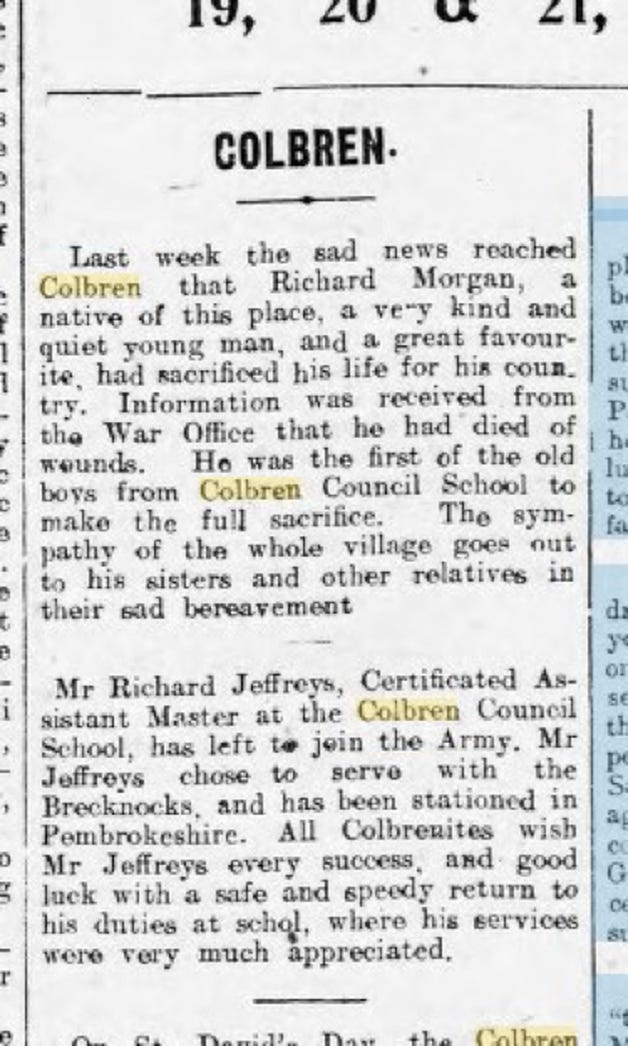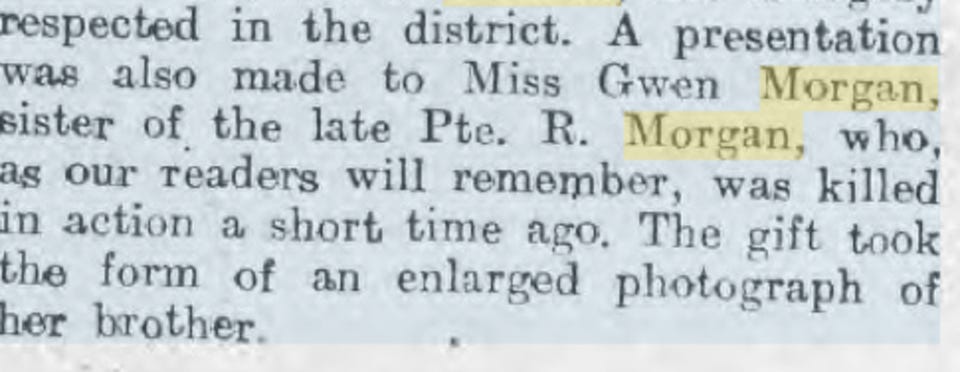John Walter Morgan’s son Richard Morgan, lasted less than three months in the First World War. Having joined the local “Pals” 14th Swansea Battalion of the Welsh Regiment, after training at Ryhl (north Wales), and camped with thousands of others at Winchester, prior to embarkation, he sailed with his comrades from Southampton to Le Havre on the 2nd December 1915.
At Winchester he had come across his cousins Daniel Jones and Jack Jeffreys, who were in the 19th Battalion: Daniel Jones wrote to his mother [Anne Morgan] in January 1916, “I just seen Dick Morgan and he just mentioned he had a nice parcel off you…” and on Jan 26, 1916, “Jack and Tom went out for a walk today Tuesday and they met Dick Morgan, he is all right.” On January 31st Daniel wrote, “I was talking to Dick Morgan today, he is in the pink of condition and we are just the same.”
He was killed somewhere around the Neuve Chappelle area in northeast France on the 21st February 1916. This was where the 38th (Welsh) Division was first engaged. Daniel Jones mentioned in his letter to his mother of March 4 1916 that “the boys were very sorry to hear about cousin Dick for he was quite happy every time I met him.” He was probably the unfortunate victim of a random sniper or shell attack on the trenches, as although this battalion was engaged at this time at the front line, this was still the slow war of attrition and the 14th Battalion did not participate in any major set-piece offensives until their famous attack on Mametz Wood (Somme) in July 1916 and later battles at Ypres (Passchendaele).
Two of Richard’s letters survive. He wrote to his aunt, Anne Jones (Morgan), a couple of weeks before his death: “Well I have not much news to tell you because I do not understand French or I would tell you more. We are having a few days rest at present but will soon be at it again, but I have got a new job on now (Brigade Bomber), don’t go in the trenches, in the stores, but under shell fire, so have been very lucky, no hard work.”
Although commemorated on a headstone at Nant-y-Ffin Chapel at Pen-y-Cae, he is buried at Vieille Chappelle military cemetery, close to where he fell in northeast France. Richard Morgan was described as a “very quiet and kind young man” in the local paper of 1916 and had had a difficult upbringing: his mother, Mary Ann, had died in 1892, the year of his birth and his father John re-married in 1895.
Only five years later, however, father John died aged only 30. Richard is thus now in the sole care of his step-mother, Anne and can be found aged 9 with her and his siblings Gwenllian and William next door to Coelbren House. He was also there in 1911. His last known address was the Miner’s Arms, Ystradgynlais – this is the address given for him on the Swansea battalion’s sailing manifest of December, 1915, his next of kin given as his sister Gwenllian.









